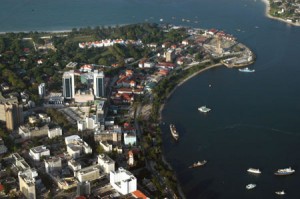In a post on August 4th 2011, yours truly wrote about Spitting on Marshall, a satirical piece about Energy & Water Utilities Regulatory Authority (EWURA)‘s disastrous directive instructing gasoline retailers to sell gasoline at their prescribed prices, which was less than before, and evidently less than what Adam Smith‘s invisible hand of the market would have dictated otherwise. In the piece, I pretty much demolish the argument that the move benefits the people, particularly those poorest among us.
I go further by citing rigorously time-tested empirical economic evidence that setting prices other than market price will always result in one of two scenarios;
(1) A shortage of the good/service in question, due to the price set below market price
or;
(2) A surplus of the good/service in question, due to the price set above market price.
In that August 4th, 2011 piece, it was the former situation that occurred. Recently, I have been peeved by another regulatory agency, this time the Surface & Marine Transport Regulatory Authority (SUMATRA). This behemoth of government recently issued a directive ordering bus fares for intercity Dar es Salaam buses or daladalas and interregional buses to be increased. Skimming through their attached pdf’s on that page, yours truly noticed that almost all routes (except some of the Kigamboni-related routes, as far as I could tell), had increased by just 100 shillings.
Now, as readers will recall in my Zebras with spots and leopards with stripes piece dating June 7th, 2011, I outline an example where good intentions do not always lead to good results. Please allow me to quote a considerable chunk of that discussion here at length, because I said it best, then.
… forcing dala dalas (public transport buses) to adhere to a price ceiling for student fares is a highly admirable thing to do. Tanzania encourages education and thus students should pay less. Result: kondaktas (bus conductors) aggressively prevent students from boarding their buses, leaving many students stranded for hours. Reason: the kondakta does the arithmetic (correctly so) that one adult is worth at least two students and since space on the bus is finite, it is optimal to get as many adults as possible rather than students. Why don’t the students who can afford the adult fares just simply pay adult fares, you might ask, as this will surely reduce the overall amount of students stranded and thus freeing up some space in subsequent trips for the less fortunate students, thus reducing average waiting times for poorer students.
The problem is, of course, that even those who can afford to pay adult fares usually never get a chance to. Having adorned a uniform, which marks her as a student, the kondaktamay never allow the student to even voice this desire to pay the adult fare. Additionally, and most importantly, the kondakta will still be skeptical to the student’s professing to pay the adult fare, because once inside (presumably comfortably on a seat) the student has every right, under the law, to renege on the initial agreement and simply pay the student fare.
Now imagine that this law did not exist and that the market chose the fare for students and adults alike (the current state is still sub optimal because there exists a ceiling on adult fares as well, and the economic argument against this ceiling still applies as well). For one, you would see less students stranded at bus stations. Secondly, and most importantly, because students would pay the same fare as adults dala dala owners would seek to increase their fleets, thus increasing the overall buses available to the public. This would reduce once again, the average waiting time for students.
Notice that in that piece, I am against the price ceiling for adult fares on daladalas. Well, some might think that SUMATRA‘s recent move is a welcome one, in my opinion. Wrong. The argument against setting prices is a symmetric one. Whether EWURA is lowering them or SUMATRA is hiking them is irrelevant. Both are wrong moves.

In this recent case, what economic theory predicts is that if these fares are too high above market price, then we should observe empty buses, as commuters opt for that original carriage——-feet. The agency only raised, on average, fares on daladalas about a quarter more from the initial fares. Daladala-owners had sought an increase of more than twice or about 149%. If the owners would have had their way, fares would have gone up from 300 shillings (as an example) to 747 shillings (possibly would have been rounded off to 750 shillings). Fares for upcountry buses have gone up, on average, about 13.2% to 20.3%. Owners here had asked for increases in the range of 35% to 48.5%. So it seems that the fares SUMATRA is putting forward are still short of what owners would want. Notice, in either case, we have no information of what consumers would be willing and able to allow.
In such an argument, SUMATRA forgets that allowing the owners to charge 750 shillings is not equivalent to the actual fare being 750 shillings. If commuters cannot afford or are unwilling to foot such fares, then the fare would be forced downward to an equilibrium, perhaps somewhere above the new fares (400 shillings for fares that were 300 shillings) but below 750 shillings, that owners pushed for.
Reactions have been varied. Some have argued that the new fares are too high, while others have sought to take SUMATRA to court, and most importantly, legislators have also decried the new fares as too high. Some daladala operators have seized the moment and charged commuters even above the new fares (highlighting that perhaps, for some, these fares are not too high). In all cases, however, the market would have revealed the true information as to whether these fares are too high, too low or just right. If the fares are too high, then consumers would substitute away into other means of commuting, until they fell to “acceptable” levels, on the aggregate. Conversely, if the fares are too low, then there would be fewer daladalas, until fares rose enough for just enough operators to find it profitable to provide this service. If the fares were just right, then nothing would change.
News coverage on the issue, on the day of the fare hike, showed that a majority of bus operators, for upcountry buses, at least, were still using old fares, fearing losses. An anecdote, recently from my travels up country to Geita, Mwanza, Korogwe, Moshi and elsewhere , I found old prices still prevailing. It seems the new fares were a bit too high for some operators. In either case, there is wastage of government resources that was spent trying to set these new fares.
Although I like to applaud government’s good deeds whenever possible (see for instance my piece on people’s Deafening Silence when government does do well), this is not one of those occasions. Government is once again Spitting on Marshall. We should always let the market do what it does best and set prices. No matter how grand government thinks they are, all emperors and empires must come to an end, like P.B. Shelley‘s epic poem, Ozymandias reminds us all. And alluring to Goldilocks’s porridge in Robert Southey‘s classic story, the market always ensures that prices are not too high, not too low, but just right.

